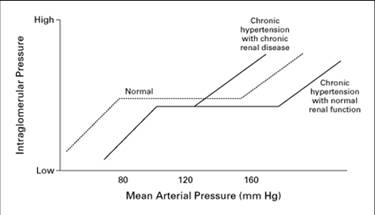|
In chronic
hypertension, the curve showing the relation of the intraglomerular pressure
to the renal perfusion pressure (or mean arterial pressure) is shifted to the
right. With the development of chronic renal failure, renal autoregulation
changes in such a way that the intraglomerular pressure begins to vary more
directly with changes in the mean arterial blood pressure. When this change
occurs, the normal sigmoidal relation becomes progressively more linear. As a
result, increases in the mean arterial pressure cause exaggerated increases
in the intraglomerular pressure, whereas declines in the mean arterial
pressure cause exaggerated decreases. Because of the rightward shift in the
lower end of the curve, antihypertensive therapy may be accompanied by a
decline in the glomerular filtration rate at a level of blood pressure that
would not affect a normal person. Renal dysfunction in this setting is
hemodynamic in origin and reflects a lower intraglomerular pressure.
|





